Lighting control
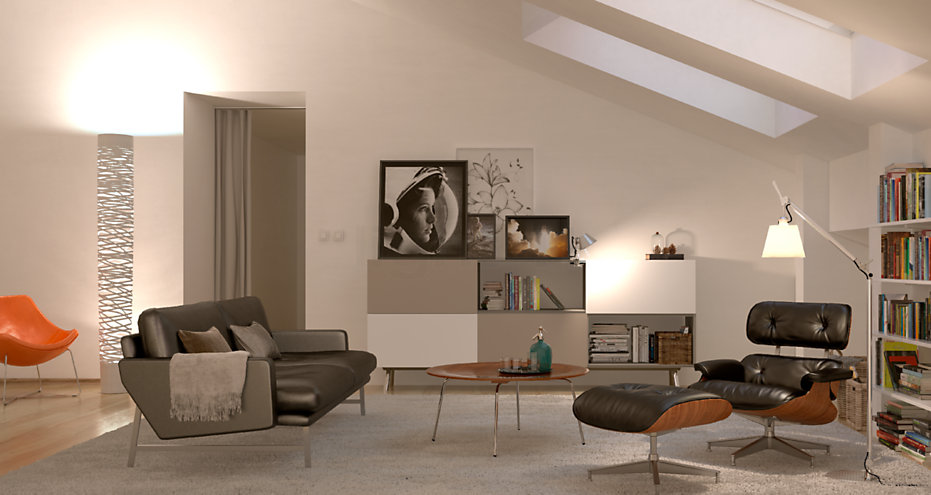
The desired lighting mood at the touch of a button
Can your home lighting be conveniently controlled using a conventional switch?
No, because there is more to lighting control than just 'on' and 'off'. Just by dimming the light, its
brightness can be adjusted to meet the most diverse requirements, for instance, you can select an intensive reading light or a subdued light to enjoy a relaxing time.
In rooms with multiple luminaires, a lighting control system can be used to activate complex light scenes for different moods – and you can achieve this by a simple push of a button. The three core elements for creating the ideal light are therefore: switching, dimming and activating light scenes.
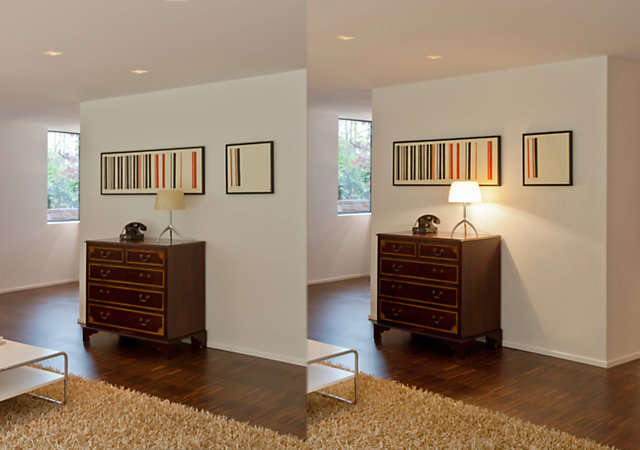
Switches – fast, flexible and simple
Light switches are usually located on the wall near the door and generally only control permanently installed lighting. They are mainly useful as a stand-alone solution in rooms where you spend little time and in which a maximum of two lights need controlling, e.g. in guest toilets, hallways or storerooms. However, for convenient, energy-saving lighting control in toilets and hallways, it is recommended to make use of motion detectors. In rooms with three or more lights, controlling the lights with switches by the door can be confusing because they can be mixed up easily.
Switches next to the door are rarely designed to control individual sockets, allowing, for example, floor lamps or table lamps to be turned on when entering the room. The disadvantage of this is that if the light is turned off using the switch on the light itself, the door switch no longer works – and vice versa.
For rooms with three or more lights, and for table and floor lamps, it is therefore recommended to use a lighting control system. When planning a sophisticated lighting control system,
professional consulting should be sought.
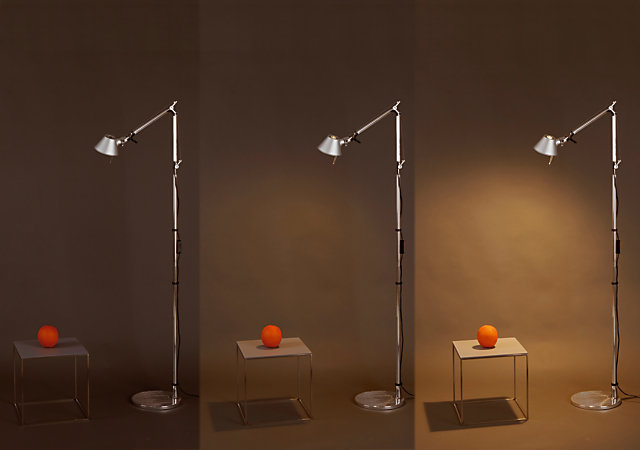
Dimmers – the perfect dimmer for your lights
Virtually all lamp types can be continuously adjusted by means of a dimmer. While special dimmer-compatible models have to be ordered for lighting designed to accommodate
light-emitting diodes (LEDs),
fluorescent lamps and
compact fluorescent lamps, all lighting designed to accommodate
incandescent lamps and halogen lamps up to a maximum of power of 400 W can generally be controlled with a dimmer.
Energy-saving lamps are generally not dimmable. However, now there are also energy-saving lamps available which can be controlled using standard leading-edge dimmers.
For permanently installed pendant lights, ceiling lights and wall lights, the dimmer is usually integrated within the wall socket of the door switch. Shock-proof plug-in lights equipped with halogen or incandescent lamps may have an integrated cord dimmer. For plug-in lights that do not come with an integrated dimmer, plug dimmers are available which you simply position between the plug and socket.
A lighting control system is also recommendable if you wish to dim all the lights in a room in a coordinated, simple and convenient manner.
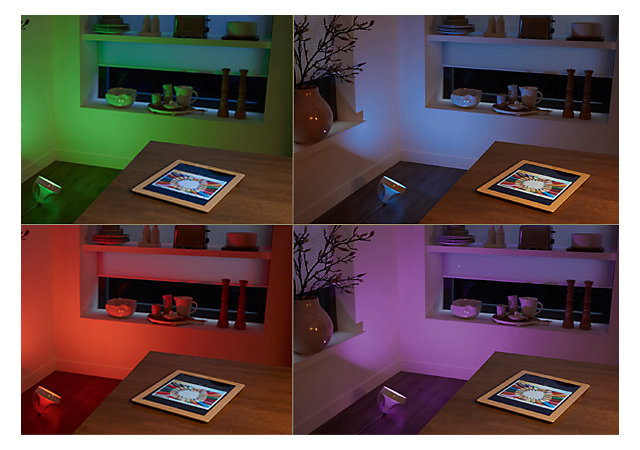
Light scenes – the perfect ambience at the touch of a button
In rooms with three or more lights, a lighting control system can be used to quickly and simply activate various light scenes to create different moods – and you can do this at the touch of a button.
This saves you from having to cross the room every evening to adjust each individual light to suit the relevant occasion. Instead, you simply press a button and the lights in the room are all set to provide the ideal illumination for a get-together, for dining, reading or watching television, etc.
Light scenes make controlling lighting moods in rooms with three or more lights an easy task. Instead of setting every light separately, simply press a button and one of your pre-set light scenes is automatically activated. When saving the light scenes, you simply determine which lights in the room should be assigned to a particular scene and how bright they should be. And you only need to do this the once.

Automatic daylight-based control – increases performance
Modern work station luminaires offer an intelligent solution for dynamic lighting – whenever it is determined that an insufficient amount of daylight is available, artificial light is added to compensate for the lacking daylight. If clouds appear, the artificial light gets brighter, and when the sun comes out, the light is dimmed again. The resulting constantly well-lit desk prevents tiredness and clearly improves performance.
Luminaires with daylight-based control can be individually requested from light11.
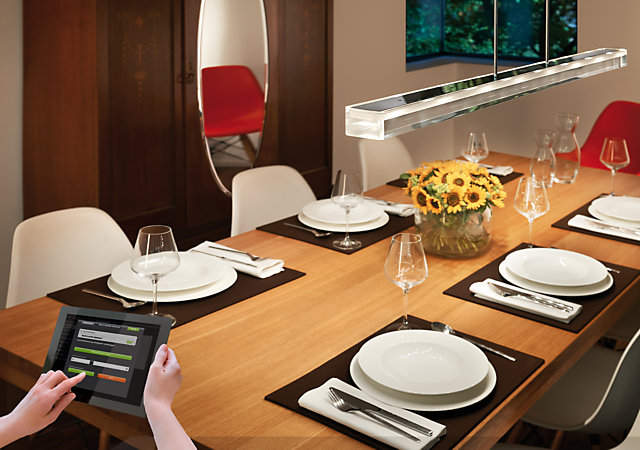
Lighting control overview
A lighting control system can be used to flexibly and conveniently control the lights in a room. The wireless control elements can be simply installed wherever they are required without subsequent time-consuming installation of wiring.
The lighting control can be used to switch the lights on and off, to dim the lights and to activate light scenes. All the lights to be integrated into the lighting control system are operated by shared radio transmitters. For this purpose, the individual lights must all be fitted with a radio receiver. Lighting controls can also be installed in standard flats at a later time without significant cost and effort.
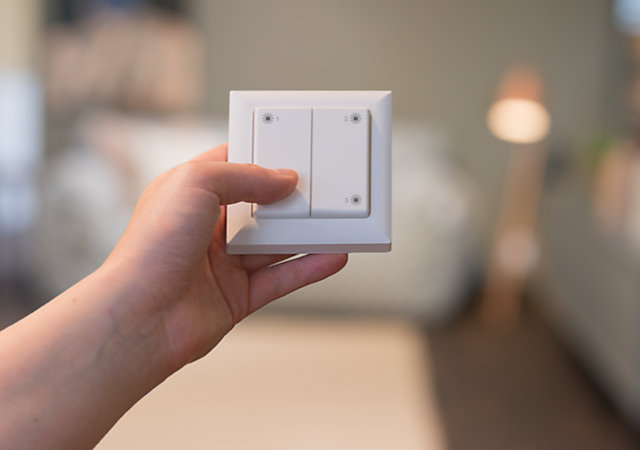
Control elements – wherever they are needed
For quickly, flexibly and easily achieving the right lighting, it is vital to locate the control elements intelligently.
Switches should always be located wherever they are required
- by the door
- in the area in which the luminaire is used, e.g. close to the dining table, the bedside table or the sofa or armchair.
But how do you arrange the switches and other control elements to be located at the desired position? The answer is simple: thanks to modern radio technology, they can be clamped or screwed onto wherever they are required without any cables being required. A remote control additionally offers maximum flexibility. Installing the control elements close to the door makes it possible to control the light on entering a room. Installing the control elements in the frequently used areas makes it possible to directly control the light. Then, the light can be controlled conveniently and without having to get up, e.g. when you are reading in bed or sitting on the sofa or in an armchair.
A remote control can be used from anywhere and allows the user to control all the luminaires within a room. Such a remote control is recommended as a supplement to the permanently installed control elements as it is not always within your reach on entering the room or when you find yourself in the area of the dining table, the bed, the sofa or the armchair.
Overview of the control elements
The following control elements are recommended for luminaires in the home:
Control elements
Function
Application
Comfort remote control
Position: variable
Overall lighting control:
Programming
All luminaires:
all on/off, bright/dark, save and activate five lighting moods
Individual luminaires and luminaire groups:
on/off, bright/dark
The remote control is needed to program all the components of the lighting control system. For mobile operation in living rooms, dining rooms and other rooms with more than 2 luminaires or luminaire groups
Basic remote control
Position: variable
Up to two individual luminaires or luminaire groups: on/off, bright/dark
In bedrooms and other rooms with up to two luminaires or luminaire groups
Triple radio-controlled button
Position: close to the door and e.g. next to sofas and armchairs
All luminaires:
all on/off activate 4 lighting moods
In living rooms, dining rooms and other rooms with more than two luminaires or luminaire groups
Single radio-controlled button
Position: close to the door and e.g. next to the bed
Individual luminaires or luminaire groups:
on/off, bright/dark
In bedrooms, kitchens, hallways and other rooms with up to two luminaires or luminaire groups
Single/double switch
Position: close to the door
Up to two individual luminaires or luminaire groups:
on/off
In basic rooms with up to two luminaires or luminaire groups
Single touch dimmer
Position: close to the door
Individual luminaires or luminaire groups:
on/off, bright/dark
In rooms with up to two luminaires or luminaire groups

Programming – simple and flexible
Each luminaire's receiver (e.g. remote socket dimmer or remote cord dimmer) has to be separately programmed and allocated to the functions (light scenes, luminaires on/off and bright/dark) of the individual transmitters (remote control, radio-controlled button). This makes it possible to individually and flexibly select and design the light control settings.
In the first step, the luminaire which corresponds to the receiver to be programmed must be switched off by briefly pressing a button on the receiver. The same button must be then pressed and held down for four seconds to activate the receiver's programming mode. Activation is indicated by a flashing LED or a pulsating sound.
The transmitter is then used to assign a light scene and, in the case of a remote control, a channel, to the luminaire's receiver, which can be used to individually control the luminaires. The successful allocation of the receiver is confirmed by a continuously illuminated LED or a continuous sound.
To assign a receiver to various light scenes and channels of a transmitter, repeat the above process, newly activating the receiver's programming mode each time. The 'all on' and 'all off' functions for remote controls are automatically allocated when a channel is assigned.
Once the luminaires' receivers have been assigned to the transmitter's channels and light scenes, the individual light scenes can be saved. To do this, the luminaires which were allocated to a light scene during programming are individually dimmed and/or turned on/off via the relevant channels on the comfort remote control. When all the luminaires for the selected light scene have been set at the desired level, the scene is saved by pressing the corresponding light scene button for a period of three seconds. Initially, the old, previously saved light scene is activated, but after three seconds the new light scene is saved and reproduced.







